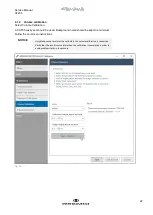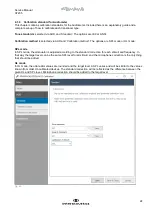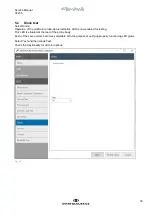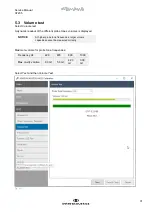
Service Manual
AT235
I
6 Appendix A – Technical Specifications
General
Medical CE-mark:
The CE-mark in combination with MD symbol indicates that Interacoustics A/S meets the
requirements of the Medical Device Regulation (EU) 2017/745.
Approval of the quality system is made by TÜV – identification no. 0123.
Standards:
Safety:
IEC 60601-1, Class I, Type B applied parts
EMC:
IEC 60601-1-2
Impedance:
IEC 60645-5 (2004)/ANSI S3.39 (2012), Type 1
Audiometer:
IEC60645-1 (2012)/ANSI S3.6 (2010), Type 4
Operation environment: Temperature:
15
°
– 35
°
C
Relative humidity:
30 – 90%
Ambient pressure:
98 kPa – 104 kPa
Warm-up time:
1 minute
Display
10 inch high resolution color display 1024x600
Transport & storage:
Storage temperature:
Transport temperature:
Relative humidity:
0
°
– 50
°
C
-20
°
– 50
°
C
10 – 95%
Internal storage
500 clients and 50.000 sessions
Internal battery
CR2032 3 V, 230 mAh, Li. Not serviceable by user
PC control:
USB:
Input/output for computer communication
Data can be sent to and saved on the PC and stored in
OtoAccess™ (Diagnostic Suite sync module is required).
Thermal printer
(Optional):
Type: MPT-III
Thermal MPT-III printer with recording paper in rolls Print
on command via USB
Power supply
UES65:
Use only specified power supply unit UE60 type
Input: 100-240 VAC 50-60 Hz, 2.5 A
Output: 24.0 VDC
Dimensions
H x W x L:
29 x 38 x 7,5 cm
AT235 weight
2.5 kg
Impedance measuring system
Probe tone:
Frequency:
Level:
226 Hz, 678 Hz, 800 Hz, 1000 Hz; pure tones; ±1%
85 dB SPL (≈ 69 dB HL) ±1.5 dB
Air pressure:
Control:
Indicator:
Range:
Pressure limitation:
Pump speed:
Automatic.
Measured value is displayed on the graphical display
-600 to +400 daPa. ±5%
-750 daPa and +550 daPa
Automatic, Fast 300 daPa/s, Medium 200 daPa/s, Slow 100
daPa/s, Very slow 50 daPa/s.
Compliance:
Range:
0.1 to 8.0 ml at 226 Hz probe tone (Ear volume: 0.1 to 8.0
ml) and 0.1 to 15 mmho at 678, 800 and 1000 Hz probe
tone. All ±5%
Test types:
Tympanometry:
Automatic, where the start and stop pressure can be user-
programmed in the setup function.
Manual control of all functions
Eustachian tube function 1 -
Non perforated eardrum:
Williams test
Eustachain tube function 2
- Perforated eardrum:
Toynbee test
Eustachian tube function 3
- Patulous Eustachian tube:
Continuous sensitive impedance measurement
Reflex functions
Signal sources:
Tone - Contra, Reflex:
250, 500, 1000, 2000, 3000, 4000, 6000, 8000 Hz, Wide
Band, High and Low pass
Tone - Ipsi, Reflex:
500, 1000, 2000, 3000, 4000 Hz wide band, high and low
pass
NB noise – Contra, Reflex:
250, 500, 1000, 2000, 3000, 4000, 6000, 8000 Hz
















































